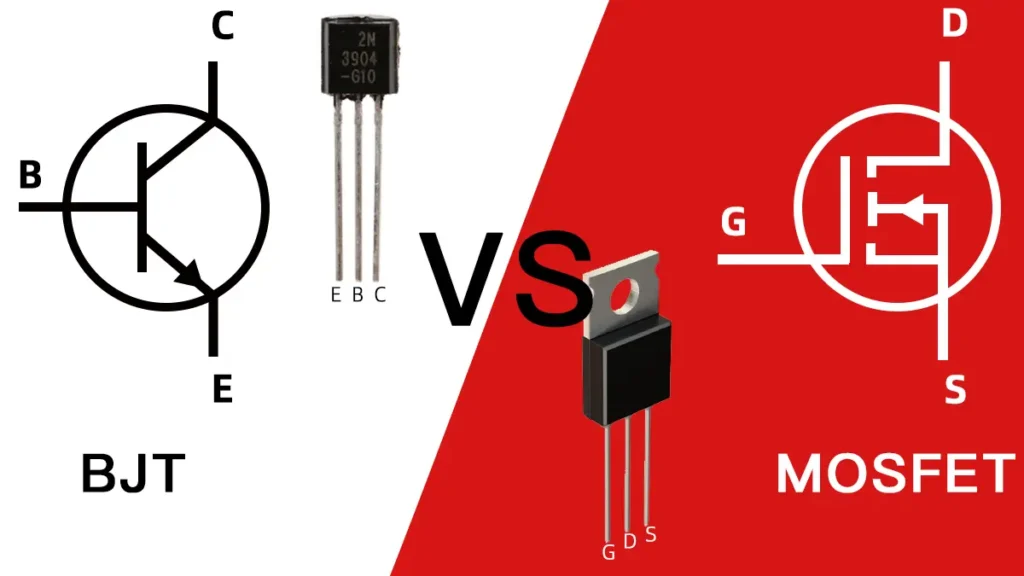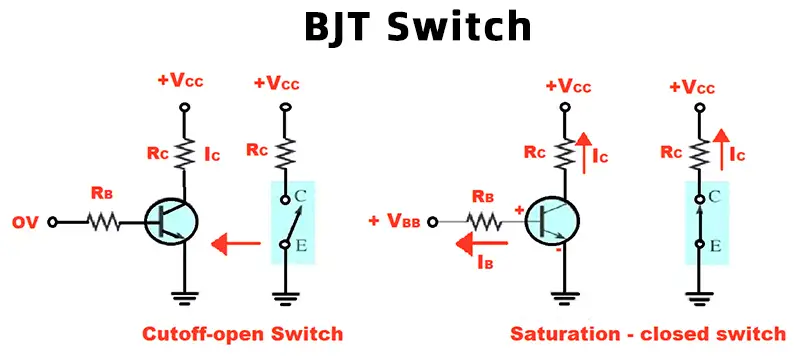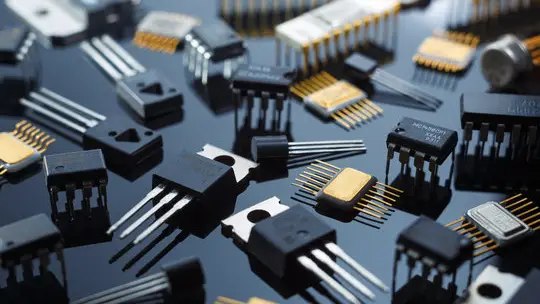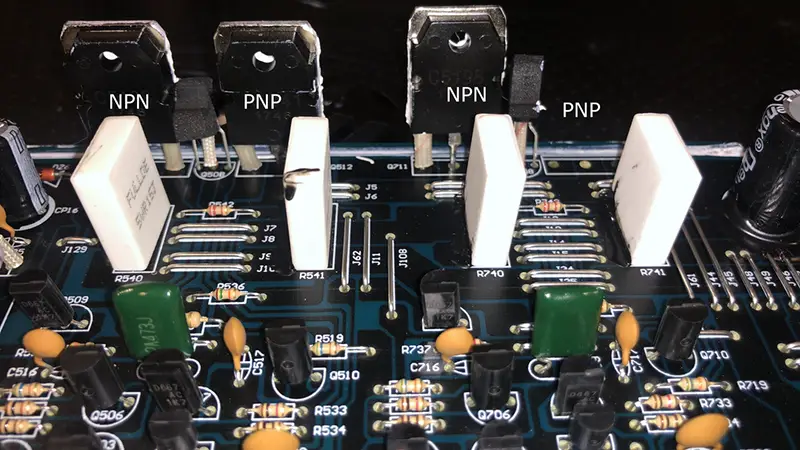Among the numerous types of transistors available, Bipolar Junction Transistors (BJTs) and Metal-Oxide-Semiconductor Field-Effect Transistors (MOSFETs) are the most commonly used. Understanding the differences between BJTs and MOSFETs is essential for making informed decisions in designing circuits and choosing the right component for specific applications.
This article delves into the intricacies of BJTs and MOSFETs, exploring their characteristics, applications, advantages, and disadvantages.
What is BJT and MOSFET?
What is BJT?
Bipolar Junction Transistors (BJTs) are three-layer semiconductor devices consisting of either two N-type materials separated by a P-type material (NPN) or two P-type materials separated by an N-type material (PNP).
BJTs control current flow and are known for their ability to handle high current densities. They operate based on the principle of current control, where a small current at the base terminal controls a larger current between the collector and emitter terminals.
What is MOSFET?
Metal-Oxide-Semiconductor Field-Effect Transistors (MOSFETs), on the other hand, are voltage-controlled devices that use an electric field to control the flow of current. MOSFETs have three terminals: gate, drain, and source. When a voltage is applied to the gate terminal, it creates an electric field that controls the current flow between the drain and source terminals. MOSFETs are popular for their high input impedance and fast switching capabilities.
What is the Difference Between BJT and MOSFET?

1. Control Mechanism
- BJT vs MOSFET: BJTs are current-controlled devices, meaning they require a continuous flow of current into the base to remain in the conducting state. In contrast, MOSFETs are voltage-controlled devices and only require a voltage applied to the gate to remain on.
2. Input Impedance
- MOSFET vs BJT: MOSFETs have significantly higher input impedance compared to BJTs. This high input impedance means that MOSFETs draw minimal current from the input signal source, making them ideal for applications requiring minimal loading on the driving circuitry.
3. Switching Speed
- BJT vs MOSFET Switching Speed: MOSFETs generally have faster switching speeds compared to BJTs. This characteristic makes MOSFETs more suitable for high-speed and high-frequency applications.
4. Power Dissipation
- MOSFET or BJT: BJTs tend to have higher power dissipation due to their continuous current control mechanism. MOSFETs, being voltage-controlled, usually dissipate less power, especially in high-speed switching applications.
5. Thermal Stability
- MOSFETs vs BJT: MOSFETs exhibit better thermal stability compared to BJTs. BJTs can suffer from thermal runaway, where an increase in temperature leads to increased current flow, further raising the temperature. MOSFETs, with their positive temperature coefficient, inherently limit current flow at higher temperatures, reducing the risk of thermal runaway.
Application of BJT and MOSFET

1. Amplifiers
- BJT vs MOSFET Amplifier: Both BJTs and MOSFETs are used in amplifier circuits, but they serve different purposes. BJTs are often used in low-noise amplifier circuits due to their superior linearity. MOSFETs are preferred in high-frequency amplifiers due to their fast switching and high input impedance characteristics.
2. Switching Applications
- BJT vs MOSFET Switch: MOSFETs are widely used in switching applications, such as power supplies and motor drives, due to their high switching speeds and low on-resistance. BJTs, although slower, are still used in some switching applications where their higher current handling capability is advantageous.
3. Digital Circuits
- MOSFET vs BJT Transistor: MOSFETs dominate the realm of digital circuits, particularly in CMOS technology, which is the backbone of modern digital integrated circuits. Their low power consumption and high switching speed make them ideal for digital applications.
4. High Power Applications
- Transistor MOSFET vs BJT: For high power applications, both BJTs and MOSFETs have their place. BJTs are used in applications where high current capacity is needed, while MOSFETs are preferred for high voltage applications due to their higher breakdown voltage capabilities.
When to Use BJT vs MOSFET?

Choosing between BJTs and MOSFETs depends on the specific requirements of your application. Here are some guidelines on when to use each type:
When to Use BJT
- High Current Density: BJTs can handle high current densities, making them suitable for applications where large currents are involved.
- Low Noise Performance: BJTs generally have better noise performance than MOSFETs, making them ideal for low-noise amplifier circuits.
- Analog Applications: BJTs are often used in analog circuits due to their good linearity and gain characteristics.
- Cost Sensitivity: In some cases, BJTs may be more cost-effective, especially for low-power applications.
When to Use MOSFET
- High-Speed Switching: MOSFETs have faster switching speeds, making them ideal for high-frequency and high-speed switching applications.
- High Input Impedance: MOSFETs draw very little current from the input source, which is beneficial in circuits requiring minimal loading on the driving circuitry.
- Digital Circuits: MOSFETs dominate digital circuit applications, particularly in CMOS technology, due to their low power consumption and high switching speed.
- Thermal Stability: MOSFETs have better thermal stability and are less prone to thermal runaway, making them suitable for applications with significant thermal variations.
- High Voltage Applications: MOSFETs have higher breakdown voltages, making them suitable for high voltage applications.
Advantages and Disadvantages of MOSFET Over BJT

Advantages of MOSFET Over BJT:
- Higher Input Impedance: MOSFETs draw very little current from the input source.
- Faster Switching Speed: MOSFETs can switch on and off much faster than BJTs, making them ideal for high-speed applications.
- Lower Power Dissipation: MOSFETs generally dissipate less power in switching applications due to their voltage-controlled nature.
- Better Thermal Stability: MOSFETs are less prone to thermal runaway compared to BJTs.
Disadvantages of MOSFET Over BJT:
- Higher Cost: MOSFETs can be more expensive than BJTs, especially for high-power applications.
- Susceptibility to Static Discharge: MOSFETs can be damaged by static discharge due to their high input impedance.
BJT and MOSFET Comparison
BJT and MOSFET Differences:
- Current vs Voltage Control: BJTs are current-controlled, while MOSFETs are voltage-controlled.
- Input Impedance: BJTs have lower input impedance compared to MOSFETs.
- Switching Speed: MOSFETs typically have faster switching speeds than BJTs.
- Power Dissipation: BJTs tend to dissipate more power than MOSFETs in switching applications.
- Thermal Stability: MOSFETs are generally more thermally stable than BJTs.
BJT and MOSFET Transistor Characteristics
Both BJTs and MOSFETs have unique characteristics that make them suitable for different applications. Understanding these characteristics is crucial for optimizing circuit performance:
- BJTs: Known for their ability to handle high current densities and low noise performance. Suitable for low-frequency analog applications.
- MOSFETs: Favored for their high input impedance, fast switching speeds, and suitability for high-frequency applications. Dominant in digital circuits and power electronics.
Conclusion
In summary, the choice between BJT and MOSFET depends on the specific requirements of the application. BJTs excel in high current and low noise applications, while MOSFETs are preferred for high-speed switching, high-frequency, and digital applications.
Whether you need a reliable amplifier, a fast switch, or a high-performance digital circuit, knowing when to use BJT vs MOSFET will ensure you achieve the desired results in your electronic designs.